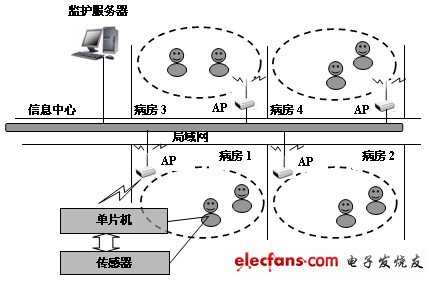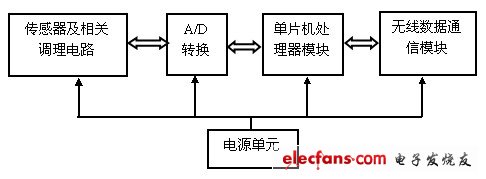With the rapid development of electronic information, in recent years, remote medical monitoring technology has gradually become a hot spot in the medical community. The remote monitoring of important life parameters brings convenience to the elderly and infirm, and also makes a great contribution to the development of the modern medical community. The telemedicine monitoring system is a high-tech industrial product that integrates information science, computer technology and communication application technology into the medical and health field. The main components of the system are: based on the microcontroller and sensor nodes to form a sign collection module, a wireless transceiver module based on GPRS / GSM, and a host computer monitoring module based on FPGA. The sign collection module uses various special sensors to collect the body signs, which are processed and packaged by the microcontroller, and uploaded to the upper computer monitoring center via the GPRS / GSM communication network. The remote doctor / guardian can monitor the patient regularly / real-time. The system has accurate measurement, strong practical innovation, high cost performance, and has a very good promotion value. 2. Design requirements Design a remote medical monitoring system. Claim: 1. Accurately collect each sign signal through the sensor nodes and submit it to the 89c51 single-chip microcomputer for processing, calculate each sign information (including body temperature, blood pressure, pulse, heart rate), form a sign collection sub-module to complete the collection of each sign information, And upload to GPRS / GSM wireless module. 2. The GPRS / GSM wireless module will receive the sign information and send it to the upper monitor accurately. 3. The upper computer based on FPGA receives the information from the lower computer and analyzes and controls it. 3. Design equipment 1. Various types of sign sensors (ASDX100 pressure sensor, HK-2000B pulse sensor, DS18B20 temperature sensor); 2. Microcontroller, GPRS / GSM module, FPGA development box; 3. Several tweezers, pliers, resistance and capacitance potentiometer wires, etc., and several solders. Fourth, the design principle and design plan 1. Design principles The remote monitoring system can be defined as a technical means to transmit the remote physical signs and medical information and medical signals to the upper computer monitoring center for analysis and give diagnosis opinions through wireless communication technology. (1) Principles of medical monitoring Remote monitoring of important life parameters is an important part of the routine monitoring of the elderly and frail. The physiological information detected mainly includes: body temperature, pulse, blood pressure, heart rate, electrocardiogram, breathing, blood gas (oxygen partial pressure and carbon dioxide partial pressure), blood Oxygen saturation, blood sugar, etc. Such physiological parameters generally require noninvasive or minimally invasive detection in remote monitoring systems. This article takes temperature, pulse, blood pressure and heart rate signals as the acquisition objects, and selects simple and convenient sensors and non-invasive measurement methods. (2) Wireless communication technology With the continuous development of information technology and the growth of social demand, wireless communication has entered a stage of large-scale development. Rapidly developing wireless communication has become the most dazzling "bright spot" in the information industry, providing various potential engineering technologies. New methods and means, and become a strong driving force to promote social development. Wireless communication shows its broad market prospects due to its features such as no need to set open wires and convenient use. Wireless communication technology is entering many products at a faster speed. Compared with wired, it mainly has the advantages of low cost, convenient portability and eliminating the trouble of wiring. It is especially suitable for remote control, telemetry, wireless meter reading, access control system, cell pager , Industrial data collection systems, wireless tags, identification, non-contact RF smart tablets, small wireless data terminals, security fire protection systems, wireless remote control systems, biological signal collection, hydrological and meteorological monitoring, machine control, information appliances, wireless 232, wireless 422 / 485 data communication and other fields. Using GPRS / GSM technology for wireless communication, the traditional serial communication is expanded to GPRS / GSM wireless network communication, and the collected data can be sent to the host computer in real time to realize the timely exchange of data and fast wireless networking of serial device. 2. Design plan (1) Hospital monitoring network system plan The hospital monitoring system is composed of wired network (local area network) and wireless network, as shown in Figure 4.1. The collection terminal worn on the patient sends the collected physiological information data (body temperature, pulse, blood pressure, heart rate) to the AP (Access Point). The AP forwards the data to the host monitoring machine through the hospital's LAN, and the host monitoring machine analyzes and processes the data. After the AP is powered on, it immediately attempts to connect to the server on the LAN. The server's IP and port number and the AP's network configuration are written in the configuration file. The user can manually modify it and enter the ready state after the connection is successful. If a patient with a mobile monitoring device enters the coverage area of ​​the AP, the mobile monitoring device will query the AP and establish an ACL link with it. The AP accepts the connection and will perform a master-slave switch to ensure that the AP can continue to be the master unit of the sensor network. Discovery and chain building of other mobile monitoring equipment. After that, SDP, L2CAP, and RFCOMM connections are made between the mobile monitoring device and the AP. The AP reports to the server that a mobile monitoring device has entered the area, and thereafter the AP will transparently forward bidirectional data between the AP and the mobile monitoring device. The host can complete the functions of control and data collection through the serial replacement function of AP and mobile monitoring equipment. When the patient leaves the coverage area of ​​this AP, the link is broken, and the AP reports to the server that the mobile monitoring device has left the area, and at the same time, the mobile monitoring device carried by the patient starts searching for a new AP. According to which AP the mobile monitoring device is connected to, the medical staff can know the patient's activity in the whole ward. Its design structure is shown in Figure 1. (2) Family monitoring network system plan The remote home monitoring network architecture is shown in Figure 2. The wireless system is mainly composed of various sensor nodes (pulse, body temperature, blood pressure, heart rate and other sensor nodes), several wireless nodes with routing functions, and a central network coordinator (monitoring base station equipment). The monitoring base station equipment connects the wireless network and Ethernet, is the core part of the home wireless network, and is responsible for the management of sensor network nodes and equipment nodes. Various sign data are transmitted to the remote monitoring server through the home gateway. The remote monitoring server is responsible for real-time collection, display and storage of pulse physiological data. The hospital monitoring center and doctors can log in to the monitoring server to view the physiological information of the monitored person, and can also remotely control the sensors and devices in the home wireless network, so that when the monitored patient becomes abnormal, it can detect and take rescue measures in time. The relatives of the guardian can also log in to the guardianship server to know the health status of the guardian at any time. V. Design process 1. Design of the sensor unit The main function of the sensor node is to collect human body sign information (including body temperature, pulse, blood pressure, heart rate), and its node mainly includes 5 parts: the central processor module (51 single chip), wireless data communication module (GPRS / GSM), sensor, A D conversion and related conditioning circuits, power modules. Node block diagram and processor unit are shown in Figure 3. 2. Design of GPRS / GSM module Introduced a remote monitoring of the data collection system on the project through the sending and receiving of GPRS / GSM short messages, which can complete the monitoring of the operation status of the data collection system on the project and the transmission of the collected data. At the same time, it can also control the data collection system through short messages to complete the specified operation. The system has its own memory, which can configure the device according to the received instructions and store it in the device's own memory. At the same time, the system is equipped with a watchdog, which can enable the system to restart the system under abnormal conditions, so that the system will never crash. Because the system uses GSM short messages as the communication carrier, it overcomes the shortcomings of unfriendly human-machine interface, high telephone charges, and low control functions. The GSM hardware diagram is shown in Figure 4 below. More design details and source code: [ see details ] Toaster, is a commonly used kitchen supplies, mainly used to bake bread. A toaster usually includes a multi-functional oven, a heat-insulating surface, a special lifting device, etc. The more advanced also includes a separable breadcrumb chassis. The toaster is a heating appliance. Its function is to generate enough heat in the vicinity of the bread to bake the bread. If there is no pop-up toaster, breakfast will certainly not be so rich nowadays. Electric Bread Maker,Home Bread Maker,Automatic Bread Maker,Portable Bread Maker Ningbo APG Machine(appliance)Co.,Ltd , http://www.apgelectrical.com
Figure 1 Structure of a hospital wireless monitoring system 
Figure 2 Home wireless monitoring system structure 
Figure 3 Monitoring sensor node structure
In many families, the toaster is more prone to failure than any other small home appliance. There are two reasons for this. First of all, the toe machine manufacturing costs are generally very low, its quality is not high. You can replace a new device with just $ 10.
Second, the toaster is often not a problem when their own failure, but the food particles interfere with its normal operation. If there are too many slices of bread on the bracket, they will fall into the bottom of the toaster and accumulate when the movement of the tray will move up, thus hindering the movement of the bracket, causing the heating element to short circuit, Open the device and affect the function of the spiral tube.
Most of the pop-up toasters are equipped with a large debris plate and have a door at the bottom, the reason for this. By sliding or opening the broken door, you can clean up the food particles that accumulate at the bottom of the toaster.
Remote medical monitoring system based on single chip and FPGA
1. Design Purpose